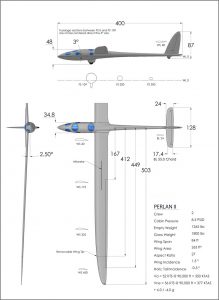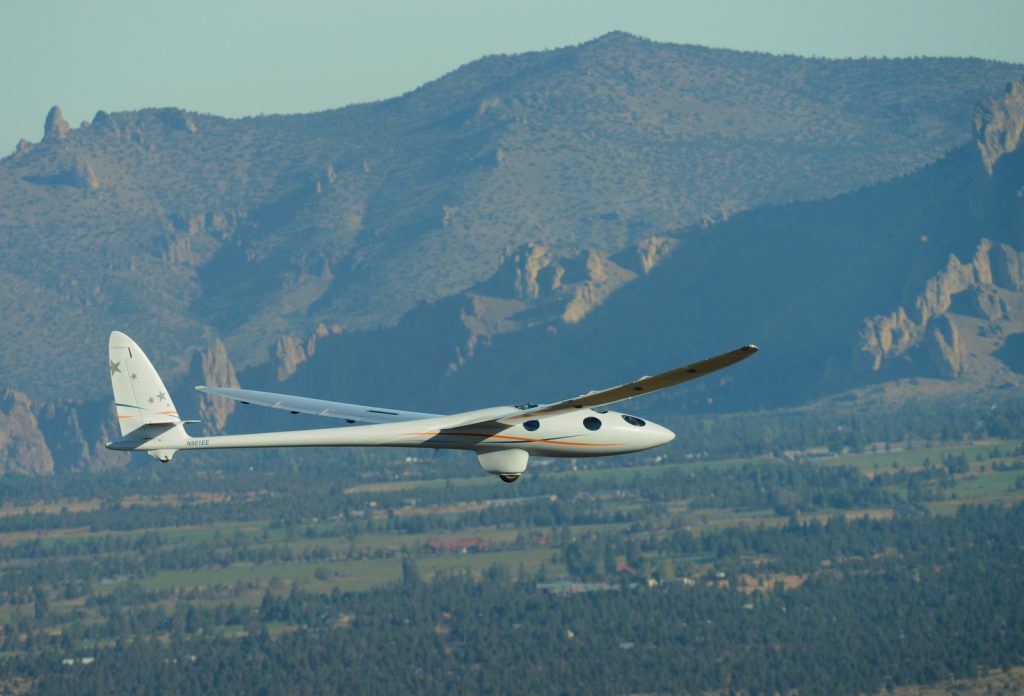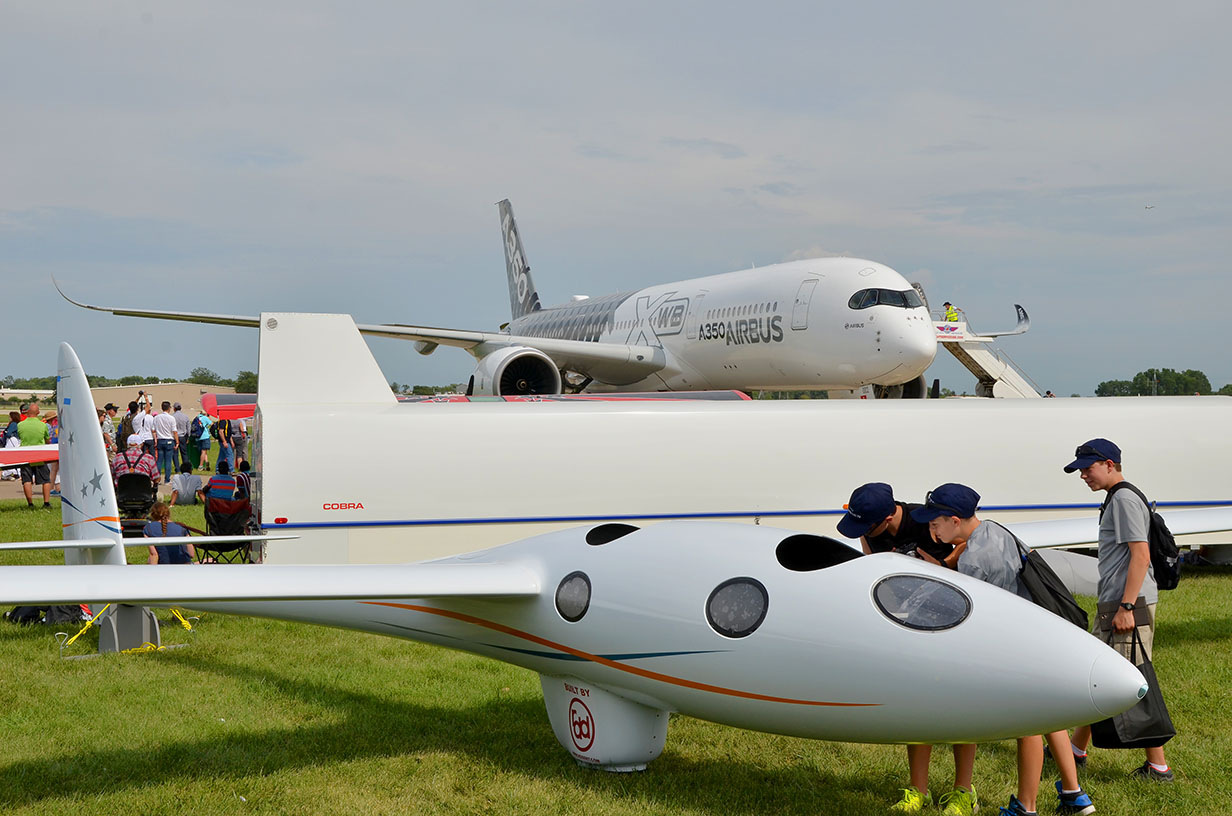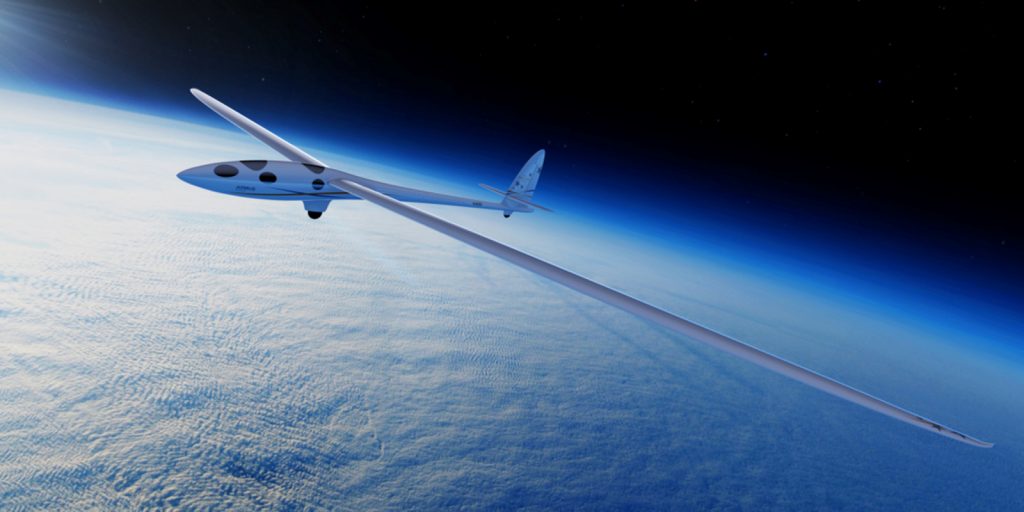Written for Flight International – Issue: July 14-20, 2015
Making its debut at EAA AirVenture 2015 is a new aircraft that’s destined to shatter records. The Airbus Perlan Mission II will use a little-known meteorological phenomenon called the Stratospheric Polar Night Jet, to reach and fly at 90,000 feet – piloted, winged and sustained flight at over 27,400m.
Perlan 2 will fly higher than the Lockheed U-2 or SR-71, but it is not an exotically-shaped or scramjet-powered superplane. It is a glider.
The idea for the record flight attempt – expected to be staged next summer in Argentina – goes back 60 years, to when a young gliding instructor called Einar Enevoldson volunteered as line-crew in the US Air Force-funded Sierra Wave Project, in Bishop, California.
Back then, the mountain wave weather phenomenon was little understood, and 2, two-seat Pratt-Reid PR-G1 gliders were flown into wave to gather meteorological and observational data, reaching altitudes as high as 44,255 feet.
When strong winds cross a mountain range, the effect can be the same as a river current flowing over rocks, and the air gets pushed into a wave behind the range. Unique, lens-shaped Lenticular Clouds are formed, and while the air in the wave is smooth with extreme rates of climb and descent, surrounding air can be violently turbulent.
Now an 83-year-old USAF and NASA flight test veteran, Enevoldson is leading a team of test pilots, programme managers and meteorologists in an attempt to achieve the first unpowered flight to over 90,000ft.
“You could see in the highest waves, it seemed that there was some major motion going on in the atmosphere at very high altitude. Something was impinging on top of the wave field,” says Enevoldson.
After a long and storied career as a USAF fighter- and test-pilot at the NASA Flight Research Center at Edwards AFB, he joined Grob Aircraft in Germany.
Research
In 1988, Enevoldson was the test pilot for Grob’s G-520 Egrett, an early “SigInt” aircraft capable of flying at 50,000 feet for eight hours. He also flew the Grob Strato 2C, a prototype high-altitude research aircraft.
Still focussed on high-altitude flight, in the early 1990s Enevoldson saw a LIDAR image taken from an aircraft flying along the Arctic Circle. “It clearly showed the wave nature of the clouds at 80,000 feet. So I said that we should build a pressurised glider and fly up to 80,000 feet. I began looking for funding for the project, and eventually met Steve Fossett.
“After a serious negotiation lasting about ten seconds, we decided to do it,” he laughs. With Fossett’s support, Enevoldson founded the Perlan Project, Inc, a not-for-profit aeronautical exploration and atmospheric scientific research organization.
Rather than starting with a pressurised design, the Perlan 1 was a modified DG Flugzeugbau DG-505m glider. Double-glass canopies were installed to eliminate frost-over, along with a NASA high-altitude oxygen system, and other mission-specific equipment. Enevoldson and Fossett wore pressure suits borrowed from NASA Dryden, and the team went to New Zealand for three seasons.
Although data suggested that the best and strongest waves were there, Perlan 1 only reached 30,000 feet.
“Steve wanted this to happen, and never gave up,” says Enevoldson. “We had no data from South America, but we looked at a map and saw El Calafate, in Patagonia, Argentina, at 50 degrees south. The first year, we went there too late, but on the first flight of the second year [August 29, 2006], we flew right into the primary wave, and went up to 34,000 feet, climbing at 2,000 feet per minute.”
But as the glider climbed through 36,000 feet, the pilots’ pressure suits became progressively stiffer, and they found it increasingly difficult to manipulate the controls and equipment. “This was as expected, but more troublesome than we had hoped,” he says.
“We were cold and tired,” says Enevoldson, “we were actually at 51,500 feet, and we knew our altimeters were accurate.” After the five-hour flight, the data recorders were sent off for verification. However, a calculation error reduced the record-setting altitude to 50,671 feet.
The Perlan team recognized that a pressurised glider would be needed to reach higher altitudes. Thought was given to “beefing up” an Alexander Schleicher ASH-25 glider, but the decision was made to create the Perlan 2, a purpose-built pressurised glider. The Perlan 1 was eventually donated to Seattle’s Museum of Flight, where it is on display.
Tragically, in September 2007, Steve Fossett was killed while flying in the Sierra Nevada Mountains. And although the design and construction of Perlan 2 continued, funding began to dry up. Looking for new partners, the project team met with Airbus in early 2014. Ken McKenzie, Senior Vice President for Strategy and Corporate Development for Airbus Group Inc, and a glider pilot himself, was in the initial meeting.
“Before the meeting, I said ‘you can’t fly a glider to 90,000 feet’, recalls McKenzie, “and when we finished the meeting we said ‘how much do you need?’ We were so enthralled with the vision they had, and what they had accomplished so far, that we had to be a part of this.”
At EAA AirVenture 2014, the project officially became the Airbus Perlan Mission II. “For us, one of the key tenets of this project is the exploration and excitement of doing something that’s never been done before,” says McKenzie. Within the company, the mission is part of Airbus Group Innovations, with McKenzie overseeing Airbus’ involvement.
With funding in place to ensure the construction of Perlan 2, the glider’s components were taken out of storage and moved to RDD Enterprises in Redmond, OR, where assembly was completed in June.
Pressurised
Perlan 2 is constructed almost fully of carbon fibre, primarily using pre-impregnated carbon sheeting and tapes. The glider has an 84 foot/25.6 meter wing made up of four, custom airfoil sections, and with an aspect ratio of 27. The airframe is designed to handle +6.0g/-4.0g loads. With an empty weight of 1,265 lbs/574 kg, the gross weight will be approximately 1,800 lbs/816 kg with two pilots and full mission equipment on board. The cabin is a sealed compartment and will be pressurised to 8.5 PSI, giving a maximum in-cabin altitude of 14,000 feet.
 “I decided that a conventional [glider] canopy wouldn’t work for a pressurised cabin,” says Enevoldson, “and I had a pretty good idea of what the cabin should look like.” Perlan 2’s cabin has plug doors and rounded windows, set in a configuration that’s been successfully flight-tested by masking the canopy of conventional gliders to match the new aircraft’s design.
“I decided that a conventional [glider] canopy wouldn’t work for a pressurised cabin,” says Enevoldson, “and I had a pretty good idea of what the cabin should look like.” Perlan 2’s cabin has plug doors and rounded windows, set in a configuration that’s been successfully flight-tested by masking the canopy of conventional gliders to match the new aircraft’s design.
“A lot of people compare our cabin design to SpaceShipOne,” says Morgan Sandercock, Project Manager and Pilot. “A couple of years ago at Oshkosh, I got the chance to shake Burt Rutan’s hand. He said ‘you’re using the same materials to solve the same problems, so of course it looks the same!’”
Inside Perlan 2’s cabin, the pilots will use a closed-loop rebreather system adapted from existing underwater breathing technology, with each pilot on an independent system. The system feeds 100% oxygen, and will scrub carbon dioxide and moisture from the pilots’ exhalations. A second tank, containing ordinary compressed air, will feed “make-up” air into the cabin, dealing with expected leakage and preventing the oxygen content of the cabin air from exceeding 26%.
The closed-loop system is very efficient, says Sandercock. “Using the rebreather function the pilots can breathe for eight hours. But if there’s a failure and we have to go to an open-loop mode, we’ve got 20 minutes in the system for an emergency descent.” In open-loop, the pilots will breathe directly from the oxygen tank, bypassing the rebreather system.
The pilots will use a custom-designed Life Support Systems Display (LSSD) to monitor and control the glider’s pressurisation and breathing systems, and an LX Avionics LX-9000 vario-navigation system will be the primary flight and information display. Perlan 2 won’t be equipped with an autopilot, but a yaw damper will be fitted. And the scientific instrument package will be mounted aft of the pressurised cabin, utilizing a CubeSat frame.
When meteorological data recommends a launch (read “How Can a Glider Climb to the Edge of Space?”), the mission profile will see Perlan 2 towed about 60 miles/100 km from El Calafate, with a release altitude of around 10,000 feet, or 3,000 meters, says Jim Payne, Chief Pilot. Payne, also an ex-USAF fighter- and test-pilot, thinks nothing of spending a day in a Schempp-Hirth Arcus glider, and flying a record-setting 1,800 km by running up and down the Sierras from Minden NV.

Perlan 2 on its first test flight, piloted by Jim Payne & Morgan Sandercock.
Photo: Perlan II Project/Airbus
“We expect the roll response to be slow at low altitude; any glider with that span is kind of sluggish,” says Payne. Perlan 2’s wing is designed to be most efficient in the 50,000 foot range, with a 200 ft/min minimum sink rate, reflecting data that shows that the weakest climb will be in that altitude region, just above the tropopause.
Once the glider penetrates the wave, there are two basic flying strategies. If the opposing wind speed is less than the glider’s best-performance speed, the pilots will crab back and forth to stay in the best climb region. But if the pilots can match the wind speed, “you just park there and go up like an elevator.” Payne says.
Stall speed of Perlan 2 is predicted to be 33 Knots Indicated Air Speed (KIAS) at 90,000 feet, with its Never Exceed Speed (Vne) at 56 KIAS. “We’ll figure out the minimum sink speed, and then we’ll know what to fly. I won’t be surprised if we spend a lot of time at 36 to 38 KIAS,” says Payne.
Although the indicated airspeeds are low, the true airspeeds will add to Perlan 2’s records. That 36 KIAS is equivalent to 242 knots, true airspeed. The opposing wind speed is expected to be above 200 knots, so “as we get high, we better be pointed west,” chuckles Payne.
Sandercock agrees, “It’s about 1,000 km from El Calafate to Port Stanley in the Falkland Islands. Downwind, we could do that in a couple of hours.”
Payne, Enevoldson, Sandercock, and Perlan 2’s other pilots will fly in the aircraft’s pressurised cabin dressed as they do for lower-altitude wave flights, in ski clothing, with down boots and electrically-heated socks. And the cabin’s carbon fibre-sandwich construction may provide good insulation against the expected -70°F/-57°C outside air temperature, says Payne. “The human body is like a 100-watt light bulb, and with the avionics in the cabin there’s actually a chance we might have a problem with too much heat in the cabin.”
If an emergency descent from 90,000 feet is ever required, Perlan 2 is equipped with a drogue parachute that has two separate activation circuits. Payne explains: “It’s sized so that we can come straight down at 80 KIAS. 80 indicated at 90,000 feet is pretty damn fast; a lot of sink rate!” In the case of a catastrophic airframe failure, the aircraft is also equipped with a ballistic parachute that’s designed to be deployed at 10,000 feet.
Perlan 2 will be on display at AirVenture, and will head back to Oregon for initial flight testing in August. Payne will fly the first flights, and once the glider’s basic performance is determined, it will be fitted out with the pressurisation and other mission-related systems. The base will shift to Minden, NV, in January 2016, to flight test all of the glider’s systems, and train ground crews and pilots.
The team will move to El Calafate in June, 2016. “Hopefully we’ll get to at least 40,000 feet in the Sierras. But when we get to Argentina, we’re not going straight to 90,000 feet,” says Payne. The incremental test program will see Perlan 2 carefully increase altitude before going for the 90,000 foot goal.
After that, Perlan 2 will continue to fly missions, exploring the region between 90,000 and 100,000 feet. Once regular operations are established, scientists may fly in the back seat to operate their research instrumentation. And flight at 100,000 feet and above might just possible, with Perlan 2 likely needing new, transonic wings to accomplish that goal.
One might wonder what can be learned from flying a glider into the stratosphere. The mission’s goals are meteorological research, aeronautical exploration, and aerodynamic advancement, with a strong emphasis on education to inspire future generations to pursue careers in math, science and research.
Airbus’ McKenzie says: “Continuous flight in that realm is something that we don’t know anything about. As we look to the future, with airspace becoming more and more congested, we may have to start looking higher and higher. As well, the atmospheric parameters above 90,000 feet approach those on Mars, so if we’re working on a spaceplane for a Mars mission, we can prove the concepts here. The data that is gathered will be a very useful outcome of the project. And I think Perlan 2 will strike a chord with the general public.”
Dennis Tito has already seen 90,000 feet on the altimeter, twice, during his Soyuz flights to and from the International Space Station in 2001. Tito is a major contributor and sponsor of the Perlan Project, and obtained his glider licence just a few years ago, at age 68.
He’ll be one of Perlan 2’s pilots, and will draw on his focussed, 650-hour mountain wave gliding experience during the missions. Tito hopes that Perlan will inspire a new generation, as he was inspired by the space program. “Everything I’ve accomplished in my career can be linked to that interest as a young person. I don’t see us having the kind of inspiration in the area of spaceflight today that we had 50 years ago. What can we do that would be new and exciting, to inspire young people? I think Perlan is one opportunity.”
Enevoldson adds, “Why do this? I think of this as an exploration. There are parts of the earth that we haven’t explored, and I’m an explorer.”


